Sun Service
Long ago, I noticed that there is not a single article about the observatory on the Hub. There are articles about telescopes, about satellites, about asteroids. But there is no article on how the habitats of astronomers are arranged. Yes there! Once upon a time there were a lot of articles about the offices of large IT companies, which boiled down to where they feed what sweets, where it is more convenient to select chairs, where which computers are used. But even these articles did not mention observatories. But in my opinion, it’s much more interesting to look at a bunch of monstrous works of human genius than to compare the lunch of a Google programmer and Apple.

Periodically, I go on business trips to various observatories. I wanted to eliminate the misunderstanding described above and write a short story on this topic. The article is devoted to the Ussuriysk Astrophysical Observatory (UAFO FEB RAS ), which is the largest observatory in the Far East. Residents of the Primorsky Territory are most likely familiar with it, but I think that it will be interesting to read for the rest. The observatory is located near Ussuriysk (20 km), but at the same time it has a good astroclimate: the illumination from the nearby city is minimal. Taiga is located almost close to the observatory. They say that sometimes even tigers wander.
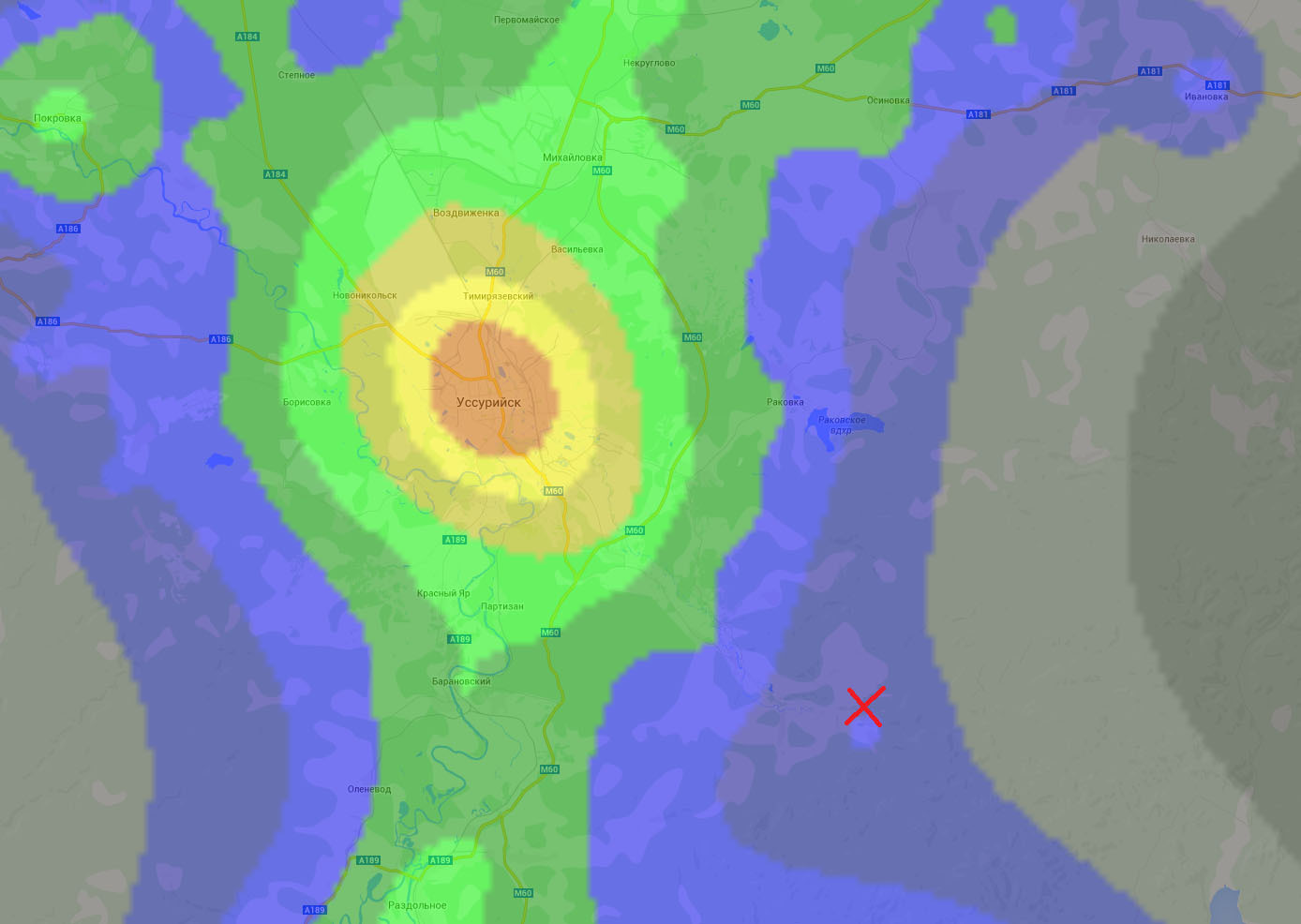
The observatory was created in 1953 for regular observations of the sun and solar activity. Then the USSR had a unique advantage that no one in the world had - it could follow the sun from the moment of its rise in the Far East and sunset in Kaliningrad. Now, when the same tasks can be performed by several satellites (SOHO and STEREO), the observatory is rather a base uniting solar researchers, with specialized tools that allow real-time data to be obtained.
Recently, the observatory has been re-equipped and now solves the problems of observing asteroids, satellites and gamma-ray bursts.
In total, the observatory has about a dozen instruments, of which 2/3 are in active use.
I myself am not familiar with the physics of the sun, and even more so with technical tricks devoted to the process of observing and collecting information. So I apologize in advance for the inaccuracies and simplifications made.
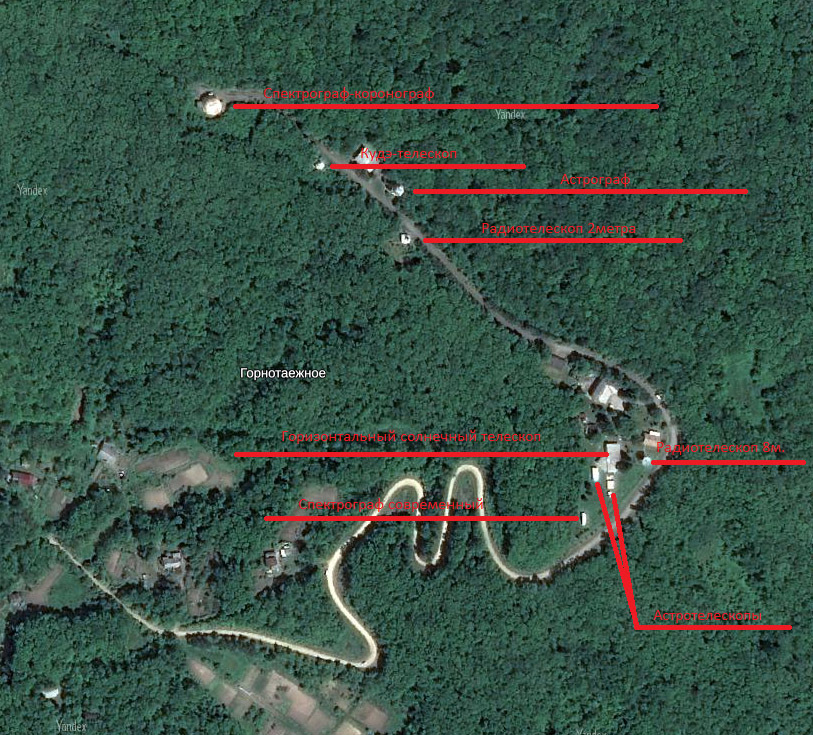
One of the oldest observatory tools is the horizontal solar telescope . Its appearance surprises a person not familiar with astronomy. But it is worth considering that the sun walks along a predictable trajectory that is almost identical day after day. A narrowly sharpened instrument does not have to have the full breadth of capabilities required of a conventional telescope.
The tool is designed to observe sunspots and analyze their spectrum.
Now it is not used. Both optics and the analyzing part are already morally and physically outdated. But that does not make them less interesting!
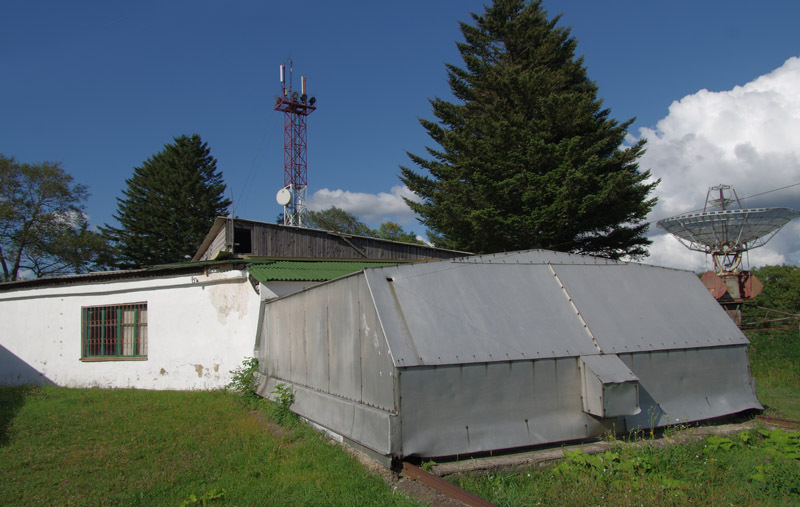
The building looks like anything, even a garage, but not a telescope. The metal part drives off on rails. Under the metal part are two adjustable mirrors that allow you to monitor the movement of the sun. The lower mirror reflects the sun in the upper, and the upper in the hole in the wall.

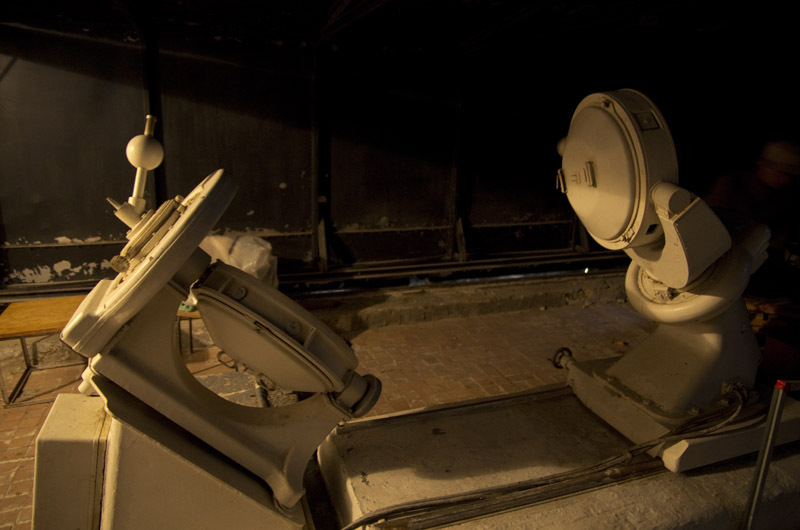
Schematically, the beam goes along such a trajectory:


The image of the sun is redirected inside the building, passing a distance of about 15 meters to the reflective diffraction grating. then it goes back where the reflector stands, redirecting the beam to the next room, where it is more accurately analyzed.
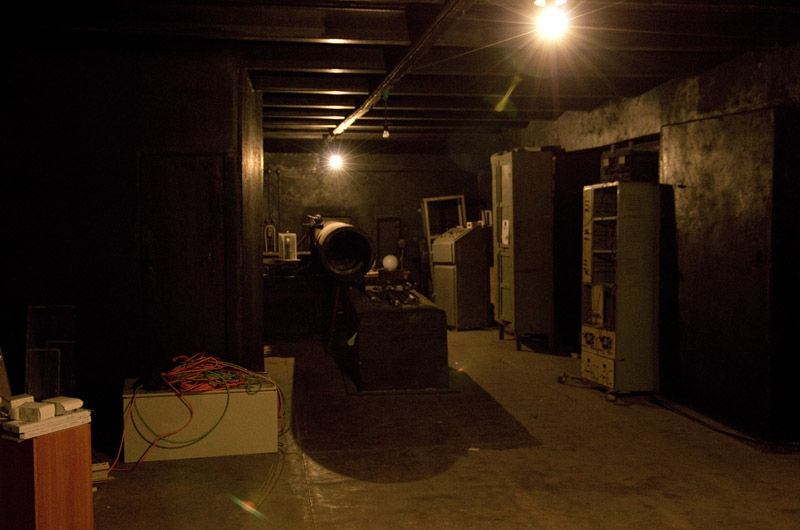
The hole from which the image of the sun comes. To the left, a reflector is visible in the cap, redirecting the return beam to the room where the analysis takes place.
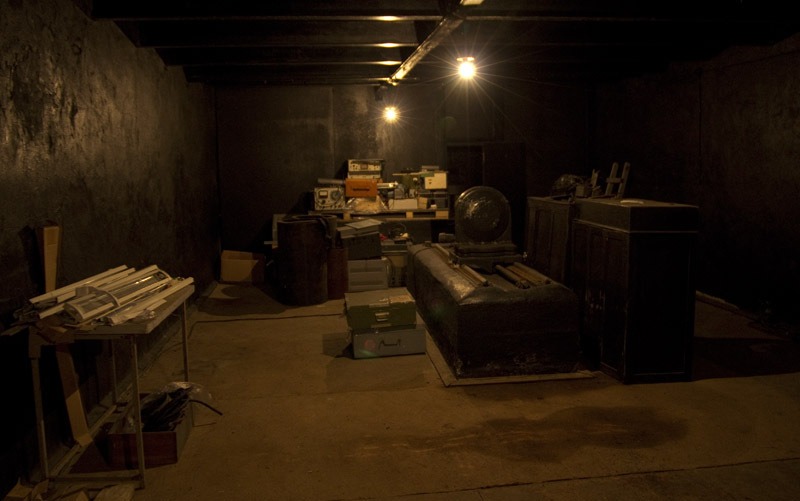
And so the diffraction grating is located. By the way, drew attention to the color of the walls? Black, he specifically - to minimize interference. When the experiment was going on, all the lights turned off.
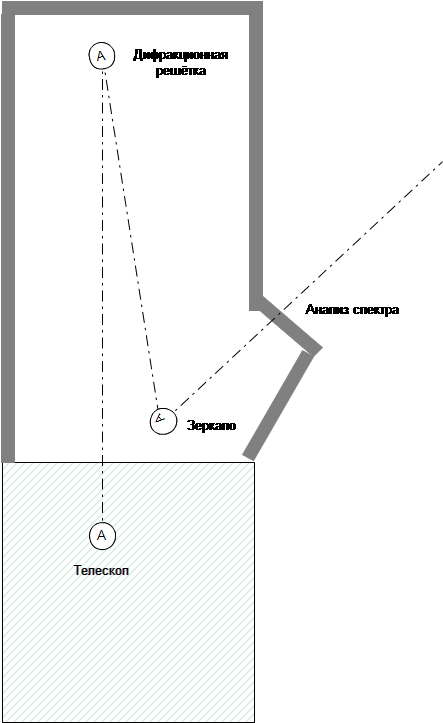
There is a lot of wonderful lamp equipment in the camps of the hall, whose era has already ended a little.
It has a slightly different scheme, more similar to a familiar telescope. Its main task is to analyze the spectrum of the corona of the sun. The equipment is a bit newer, but recently it has not been used either.
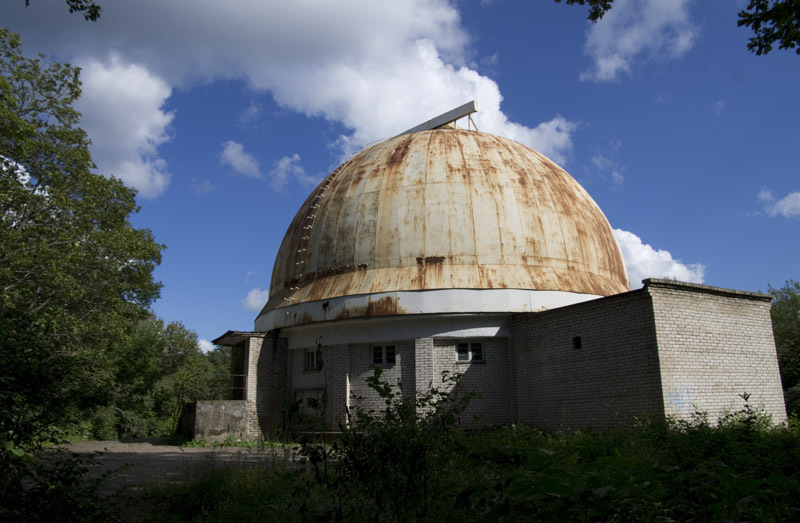
The telescope tube has a truss design that allows you to compensate for the deformation of the optical axis and constantly accompany the solar disk, avoiding displacements. A lens with a diameter of 50 cm collects the light flux from the sun and directs it to the spectral hall using an additional system of mirrors. Next, an artificial Moon is set in the path of the light flux, and this can be used to simulate a solar eclipse when it is convenient and necessary, without waiting for such a rare occurrence. The solar corona and the chromosphere are the outer atmosphere of the Sun, which we do not see because of the greater brightness of the disk itself, and only after eclipsing it, it opens in all its glory for admiring and studying.
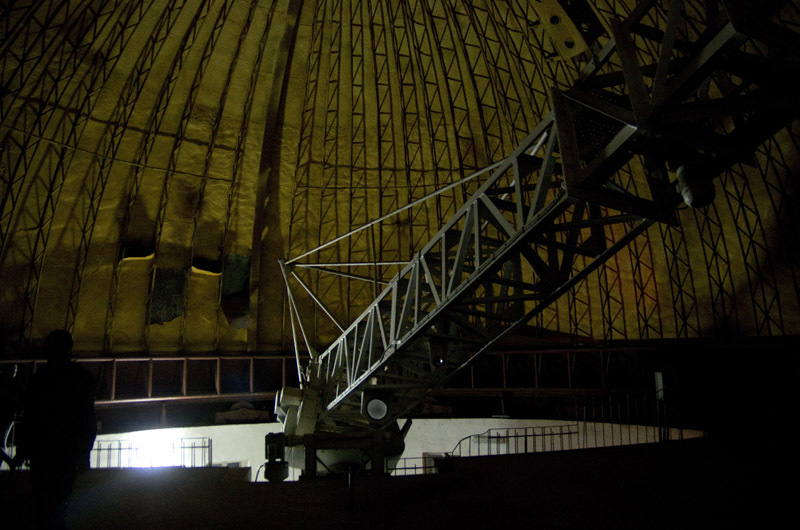
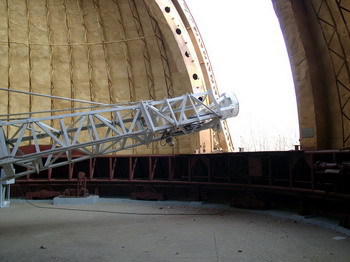
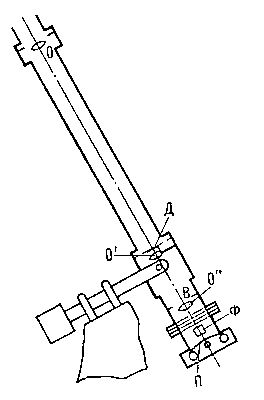
A slightly more detailed description of the action: An extra-corridor coronograph consists of the main lens O, which builds the image of the Sun on a metal disk D, which does not pass the light of the photosphere further and thus creates an artificial eclipse. To eliminate the scattered light that appears due to diffraction from the edge of the main lens, an O 'lens is placed behind the metal screen, which builds an image of the main lens on the aperture B with a hole small enough not to miss the image of the edges of the main lens. The next lens O "builds the final image of the crown or prominences on the slit of the spectrograph or on P.'s film
The reader, having crossed the first two spectrographs, will be surprised to ask, “Why not upgrade these spectrographs, saturate them with modern equipment, and bring them to work?”. But ... It is too expensive, complicated and unjustified. Do you know what a modern solar spectrograph looks like? Here it is: The

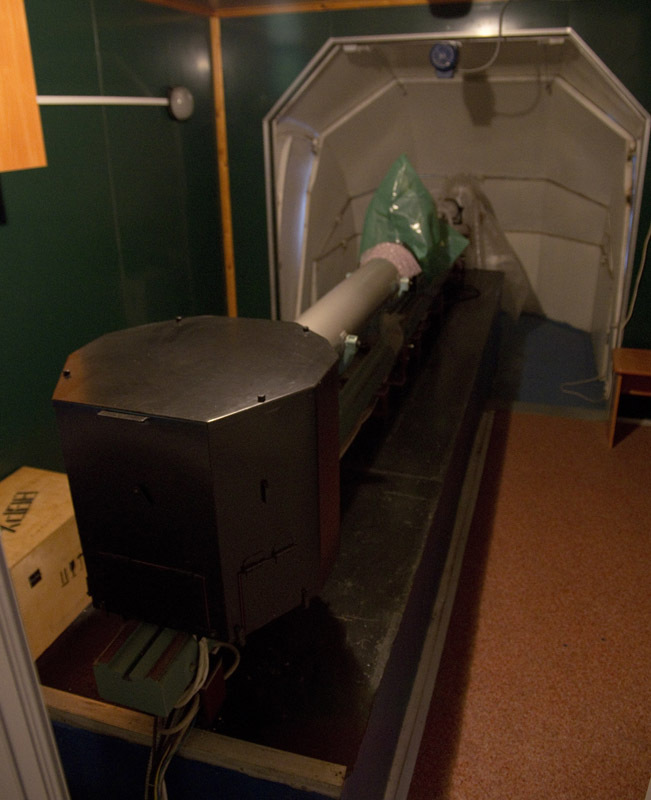
white part of the cabin leans back. A small telescope sends the image to a black box where the spectrum analyzers are located.
Moreover, it is serviced by one operator, receives the result instantly, allows you to quickly analyze it and transmit it to the consumer. By the way, the spectrograph belongs to RosHydroMet and is still being commissioned.
I could not find out the exact characteristics of all spectrographs, but as it seems to me from some experience, in modern ones they are not much worse. But the modern one allows you to get a magnetogram of the entire solar disk in 10 minutes and make a very quick forecast of space weather.
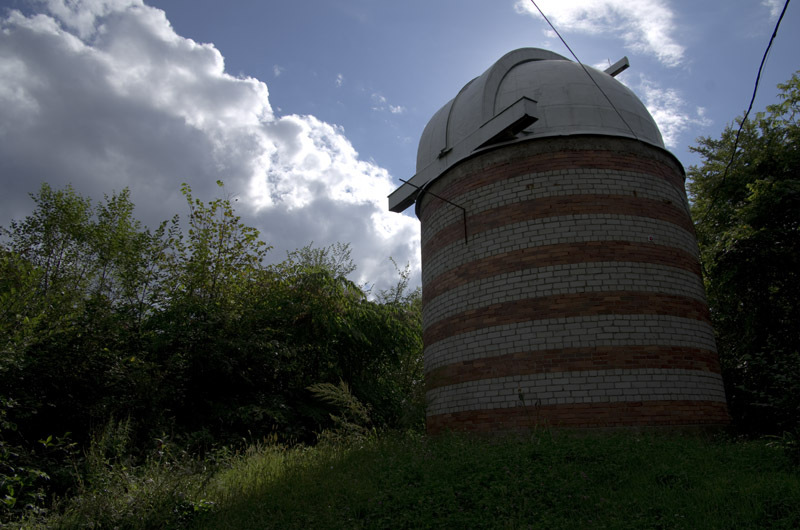
But spectral telescopes are not the only telescopes that are installed in the observatory. The observatory has a number of telescopes for ordinary optical observation of the sun. First of all, this is this telescope:
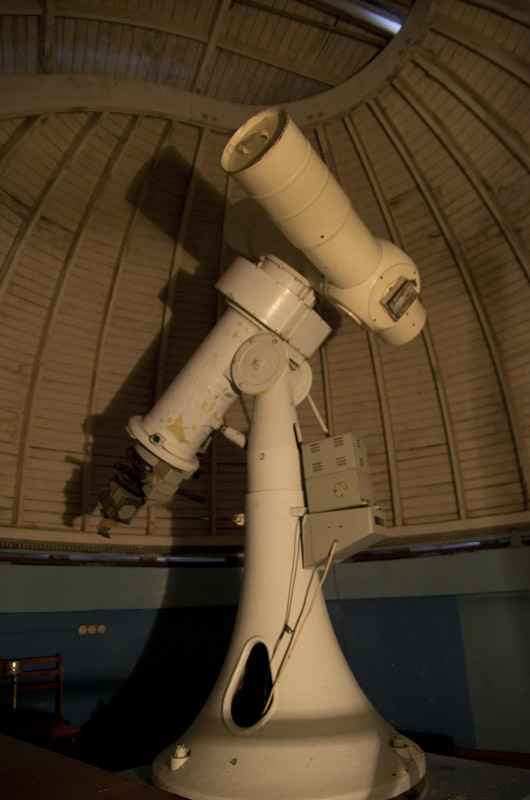
The telescope is an example of the fact that a fairly old telescope can be used with completely modern matrices. By the way, pay attention to an interesting scheme: the image enters that part of the pipe, which is located on the top, and is fixed at the bottom left.

In addition, the observatory has a telescope that performs constant observations of the sun through a hydrogen filter. This method allows you to observe the chromosphere of the sun, eliminating the influence of the photosphere. With such a filter, one can examine the prominences and dynamics of the upper layers of the Sun. And get such awesome pictures .

Back to the old technique. Who lives in this house?
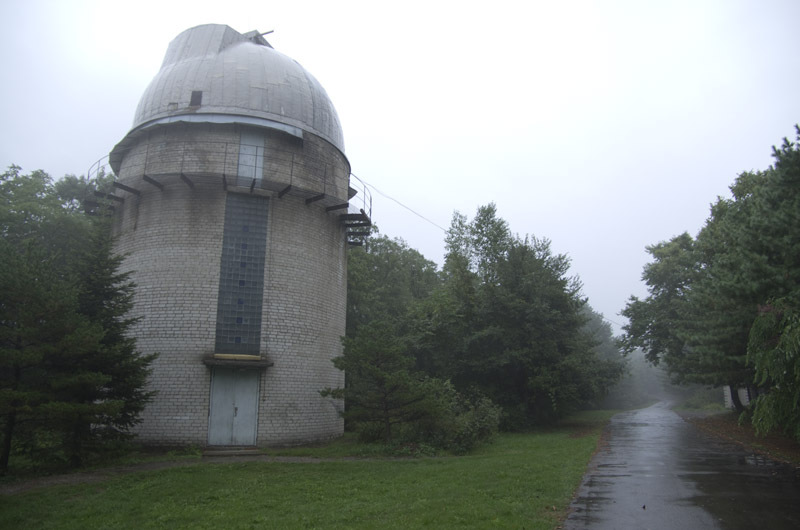
The astrograph lives in this house. Unfortunately, a little late with his era. Bought before perestroika, it was very modern at that time. But perestroika soon began, there was no money, there were no photographic plates for him. And when the money appeared, he was already obsolete: the era of numbers began.
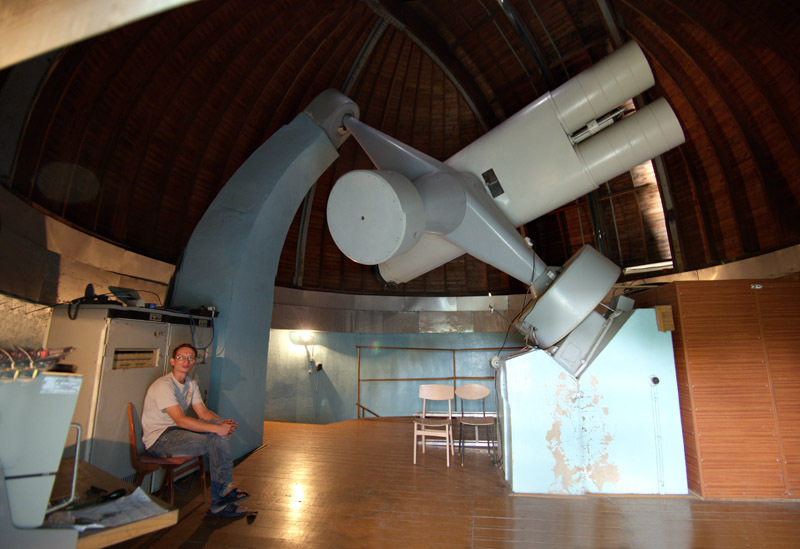
The first question that burst out from me was “why do he need two pipes?”. The answer turned out to be unusual for me, a person of the era of digital cameras. It turns out that when exposing photographic plates there is a chance to get a “knocked out pixel”, a point with local overexposure or overexposure. In order to level out such artifacts, systems are used that make it possible to simultaneously expose two identical photographic plates on the same regions of the sky. And here is where the photographic plates were placed:

The second miracle of this telescope is located in these drums and in this installation:

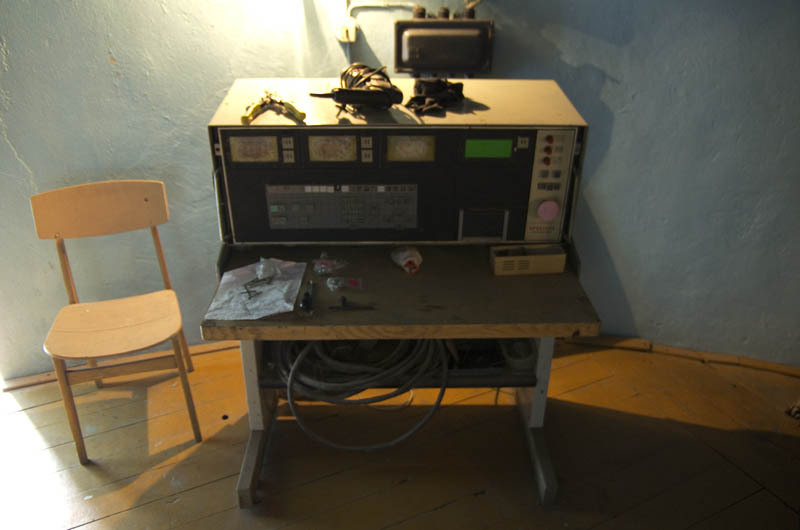
This is an automatic guidance system, quite modern at that time. In the drums are encoders on the Gray code , and the box is the control computer.
Gray code is a number system in which two adjacent values differ in only one digit. Originally intended to protect against false triggering of electromechanical switches. The telescope uses the optical code of Gray in the drums. The sensor reads the current position and allows you to aim at the starry sky automatically with an accuracy of angular second.

Unfortunately, the telescope is already obsolete. Nobody needs neither photographic plates, nor the narrow field of the telescope, nor the large resolvable field in the focus plane. Today’s telescopes look like this:
All three of these telescopes are much smaller, simpler, more compact and more efficient than the monstrous astrograph from the pictures above. Today they are used to observe gamma-ray bursts, asteroids, comets and high-altitude satellites. Two large ones give not only a larger field, but also better photosensitivity.
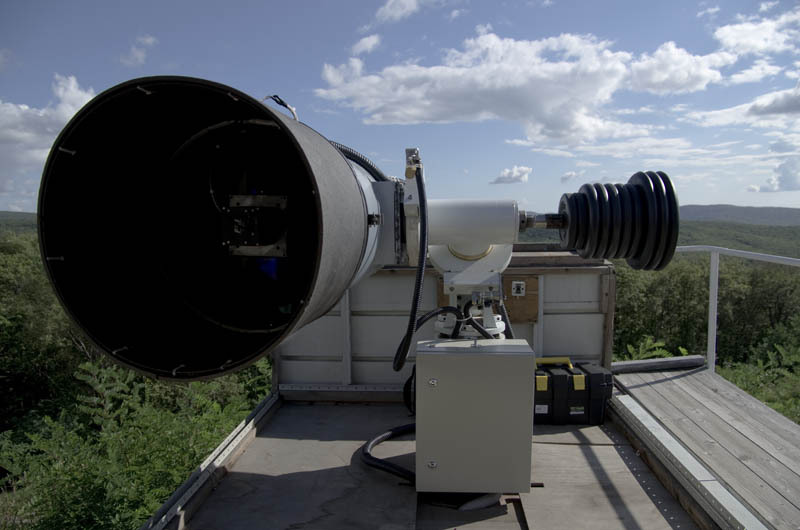
50 cm telescope.

60 cm telescope + 20 cm telescope.
These telescopes very effectively solve the problems of the ISON project , as well as warnings about asteroid and comet hazard. A number of asteroids have been discovered .
The observatory has two radio telescopes. One, sunny, working:
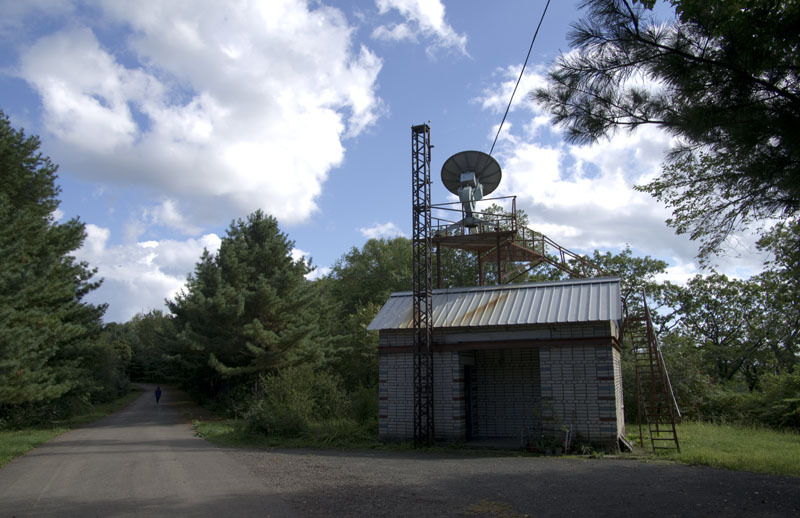
And the second, a gift from the military, which has not yet been launched, but really wants.
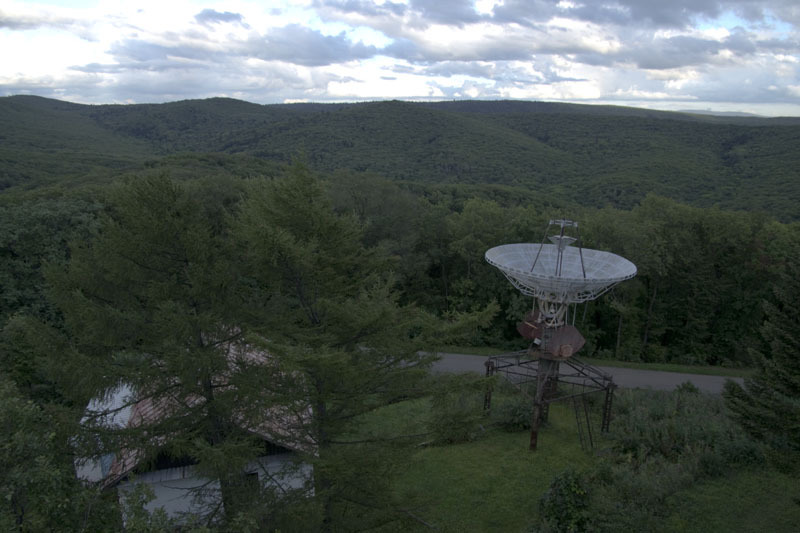
I must say that in the component of everyday life the observatory loses much to both Google and Yandex :) It is difficult to conduct stable water, Internet and electricity to a distant mountain. Everything is there, but unstable. Do not defeat the observatory in the competition of more delicious cookies.
But it’s beautiful here. Around the taiga, cedar pine trees entwined with grapes and actinidia (the younger brother of kiwi). Boars and other animals are heard at night. Sometimes, they say, tigers pass nearby. The end of the day marks the dawn and fog covering the hills. A kilometer from the observatory, the largest arboretum in the Far East.
Why do we need coolers with Coca-Cola and tables with cookies when you can go to the taiga for a break between work ?! Z.Yu. Many thanks to Alexei for the tour!


Periodically, I go on business trips to various observatories. I wanted to eliminate the misunderstanding described above and write a short story on this topic. The article is devoted to the Ussuriysk Astrophysical Observatory (UAFO FEB RAS ), which is the largest observatory in the Far East. Residents of the Primorsky Territory are most likely familiar with it, but I think that it will be interesting to read for the rest. The observatory is located near Ussuriysk (20 km), but at the same time it has a good astroclimate: the illumination from the nearby city is minimal. Taiga is located almost close to the observatory. They say that sometimes even tigers wander.

The observatory was created in 1953 for regular observations of the sun and solar activity. Then the USSR had a unique advantage that no one in the world had - it could follow the sun from the moment of its rise in the Far East and sunset in Kaliningrad. Now, when the same tasks can be performed by several satellites (SOHO and STEREO), the observatory is rather a base uniting solar researchers, with specialized tools that allow real-time data to be obtained.
Recently, the observatory has been re-equipped and now solves the problems of observing asteroids, satellites and gamma-ray bursts.
In total, the observatory has about a dozen instruments, of which 2/3 are in active use.
I myself am not familiar with the physics of the sun, and even more so with technical tricks devoted to the process of observing and collecting information. So I apologize in advance for the inaccuracies and simplifications made.

Horizontal solar telescope
One of the oldest observatory tools is the horizontal solar telescope . Its appearance surprises a person not familiar with astronomy. But it is worth considering that the sun walks along a predictable trajectory that is almost identical day after day. A narrowly sharpened instrument does not have to have the full breadth of capabilities required of a conventional telescope.
The tool is designed to observe sunspots and analyze their spectrum.
Now it is not used. Both optics and the analyzing part are already morally and physically outdated. But that does not make them less interesting!

The building looks like anything, even a garage, but not a telescope. The metal part drives off on rails. Under the metal part are two adjustable mirrors that allow you to monitor the movement of the sun. The lower mirror reflects the sun in the upper, and the upper in the hole in the wall.


Schematically, the beam goes along such a trajectory:


The image of the sun is redirected inside the building, passing a distance of about 15 meters to the reflective diffraction grating. then it goes back where the reflector stands, redirecting the beam to the next room, where it is more accurately analyzed.

The hole from which the image of the sun comes. To the left, a reflector is visible in the cap, redirecting the return beam to the room where the analysis takes place.

And so the diffraction grating is located. By the way, drew attention to the color of the walls? Black, he specifically - to minimize interference. When the experiment was going on, all the lights turned off.

There is a lot of wonderful lamp equipment in the camps of the hall, whose era has already ended a little.
Spectrograph-coronograph (Extra-eclipse Corongraph).
It has a slightly different scheme, more similar to a familiar telescope. Its main task is to analyze the spectrum of the corona of the sun. The equipment is a bit newer, but recently it has not been used either.

The telescope tube has a truss design that allows you to compensate for the deformation of the optical axis and constantly accompany the solar disk, avoiding displacements. A lens with a diameter of 50 cm collects the light flux from the sun and directs it to the spectral hall using an additional system of mirrors. Next, an artificial Moon is set in the path of the light flux, and this can be used to simulate a solar eclipse when it is convenient and necessary, without waiting for such a rare occurrence. The solar corona and the chromosphere are the outer atmosphere of the Sun, which we do not see because of the greater brightness of the disk itself, and only after eclipsing it, it opens in all its glory for admiring and studying.



A slightly more detailed description of the action: An extra-corridor coronograph consists of the main lens O, which builds the image of the Sun on a metal disk D, which does not pass the light of the photosphere further and thus creates an artificial eclipse. To eliminate the scattered light that appears due to diffraction from the edge of the main lens, an O 'lens is placed behind the metal screen, which builds an image of the main lens on the aperture B with a hole small enough not to miss the image of the edges of the main lens. The next lens O "builds the final image of the crown or prominences on the slit of the spectrograph or on P.'s film
Another spectrograph
The reader, having crossed the first two spectrographs, will be surprised to ask, “Why not upgrade these spectrographs, saturate them with modern equipment, and bring them to work?”. But ... It is too expensive, complicated and unjustified. Do you know what a modern solar spectrograph looks like? Here it is: The


white part of the cabin leans back. A small telescope sends the image to a black box where the spectrum analyzers are located.
Moreover, it is serviced by one operator, receives the result instantly, allows you to quickly analyze it and transmit it to the consumer. By the way, the spectrograph belongs to RosHydroMet and is still being commissioned.
I could not find out the exact characteristics of all spectrographs, but as it seems to me from some experience, in modern ones they are not much worse. But the modern one allows you to get a magnetogram of the entire solar disk in 10 minutes and make a very quick forecast of space weather.
Solar telescope (Kude refractor)

But spectral telescopes are not the only telescopes that are installed in the observatory. The observatory has a number of telescopes for ordinary optical observation of the sun. First of all, this is this telescope:

The telescope is an example of the fact that a fairly old telescope can be used with completely modern matrices. By the way, pay attention to an interesting scheme: the image enters that part of the pipe, which is located on the top, and is fixed at the bottom left.
Solar telescope (with H-filter)

In addition, the observatory has a telescope that performs constant observations of the sun through a hydrogen filter. This method allows you to observe the chromosphere of the sun, eliminating the influence of the photosphere. With such a filter, one can examine the prominences and dynamics of the upper layers of the Sun. And get such awesome pictures .

Astrograph
Back to the old technique. Who lives in this house?

The astrograph lives in this house. Unfortunately, a little late with his era. Bought before perestroika, it was very modern at that time. But perestroika soon began, there was no money, there were no photographic plates for him. And when the money appeared, he was already obsolete: the era of numbers began.

The first question that burst out from me was “why do he need two pipes?”. The answer turned out to be unusual for me, a person of the era of digital cameras. It turns out that when exposing photographic plates there is a chance to get a “knocked out pixel”, a point with local overexposure or overexposure. In order to level out such artifacts, systems are used that make it possible to simultaneously expose two identical photographic plates on the same regions of the sky. And here is where the photographic plates were placed:

The second miracle of this telescope is located in these drums and in this installation:


This is an automatic guidance system, quite modern at that time. In the drums are encoders on the Gray code , and the box is the control computer.
Gray code is a number system in which two adjacent values differ in only one digit. Originally intended to protect against false triggering of electromechanical switches. The telescope uses the optical code of Gray in the drums. The sensor reads the current position and allows you to aim at the starry sky automatically with an accuracy of angular second.

Unfortunately, the telescope is already obsolete. Nobody needs neither photographic plates, nor the narrow field of the telescope, nor the large resolvable field in the focus plane. Today’s telescopes look like this:
Modern telescopes
All three of these telescopes are much smaller, simpler, more compact and more efficient than the monstrous astrograph from the pictures above. Today they are used to observe gamma-ray bursts, asteroids, comets and high-altitude satellites. Two large ones give not only a larger field, but also better photosensitivity.

50 cm telescope.

60 cm telescope + 20 cm telescope.
These telescopes very effectively solve the problems of the ISON project , as well as warnings about asteroid and comet hazard. A number of asteroids have been discovered .
Radio telescopes
The observatory has two radio telescopes. One, sunny, working:

And the second, a gift from the military, which has not yet been launched, but really wants.

Other little things in life
I must say that in the component of everyday life the observatory loses much to both Google and Yandex :) It is difficult to conduct stable water, Internet and electricity to a distant mountain. Everything is there, but unstable. Do not defeat the observatory in the competition of more delicious cookies.
But it’s beautiful here. Around the taiga, cedar pine trees entwined with grapes and actinidia (the younger brother of kiwi). Boars and other animals are heard at night. Sometimes, they say, tigers pass nearby. The end of the day marks the dawn and fog covering the hills. A kilometer from the observatory, the largest arboretum in the Far East.
Why do we need coolers with Coca-Cola and tables with cookies when you can go to the taiga for a break between work ?! Z.Yu. Many thanks to Alexei for the tour!

Only registered users can participate in the survey. Please come in.
If you have the opportunity to tell more about some observatory, should this be done?
- 95.4% needed. 1588
- 4.5% Well, nafig. They are all the same. 75
